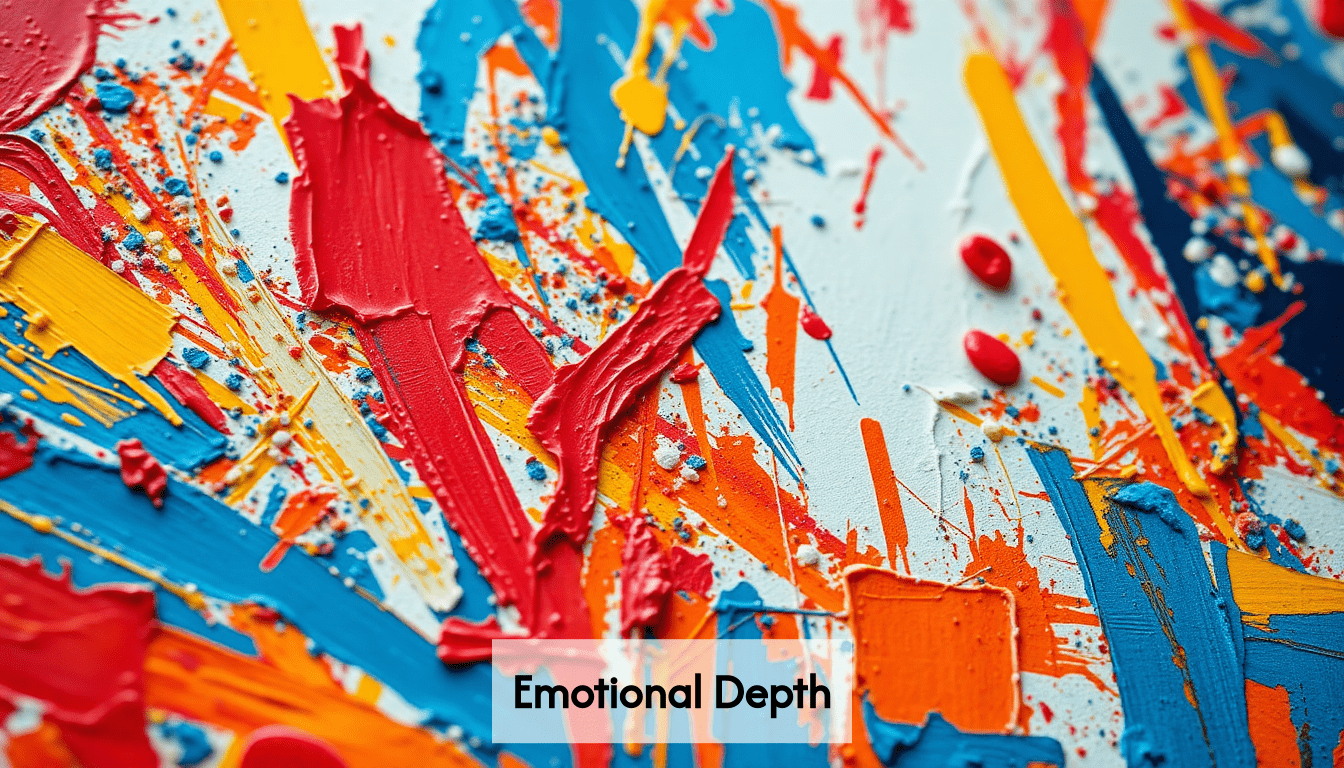Abstract Expressionism: Important New Idea & Lasting Effect
The Abstract Expressionist Movement, an American art movement that emerged in the mid-20th century, revolutionized the art world with its innovative approaches and profound emotional depth. This movement, characterized by its bold use of color and dynamic compositions, posed a major and lasting effect on modern art. Artists within this movement sought to portray the subconscious, emphasizing the act of painting as a means of personal expression. This article explores the origins, key figures, and enduring impact of Abstract Expressionism, highlighting its important new ideas and the profound legacy it left on the artistic landscape.
What is Abstract Expressionism and How Did It Emerge?
Origins of the Abstract Expressionist Movement
The Abstract Expressionist Movement emerged in the United States during the 1940s, primarily in response to the changing cultural and political landscape of the time. As the world grappled with the aftermath of World War II, artists sought new ways to express the complexities of the human experience. The movement was rooted in earlier European modernist traditions, including Surrealism and Cubism, but it marked a distinct departure by prioritizing spontaneity and emotional intensity. The Abstract Expressionists embraced the freedom to explore their inner psyches, utilizing abstract forms and innovative painting techniques to convey a wide range of emotions and ideas.
The Role of New York City in the Movement's Development
New York City played a crucial role in the development of the Abstract Expressionist Movement, becoming its epicenter and nurturing hub. During the post-war era, many European artists sought refuge in New York, bringing with them diverse influences and fresh perspectives. The city's vibrant cultural scene and burgeoning art community provided an ideal environment for experimentation and collaboration. Galleries such as the Betty Parsons Gallery and the Museum of Modern Art became instrumental in promoting Abstract Expressionist artists, propelling them to national and international prominence. The dynamic and cosmopolitan atmosphere of New York City fostered a spirit of innovation, enabling the movement to flourish.
Influence of World War II on Abstract Expressionism
World War II had a profound impact on the Abstract Expressionist Movement, shaping its themes and sensibilities. The war's devastation and displacement prompted artists to grapple with existential questions and explore the depths of human emotion. The movement's emphasis on individual expression and introspection can be seen as a response to the collective trauma of the war. Artists sought to convey the chaos and uncertainty of the times through dynamic compositions and bold gestures. The Abstract Expressionists' commitment to authenticity and emotional truth resonated with audiences, offering a cathartic outlet amidst the turmoil of the post-war era.
What New Idea Did the Abstract Expressionist Movement Introduce?
Innovative Painting Techniques and Mediums
The Abstract Expressionist Movement introduced several important new ideas in the realm of painting techniques and mediums. Artists like Jackson Pollock revolutionized the act of painting with his signature drip technique, which involved pouring and splattering paint onto large-scale canvases. This approach emphasized the physicality and spontaneity of the creative process, allowing for a direct connection between the artist and the artwork. The movement also embraced unconventional materials, such as industrial paints and commercial-grade canvas, further challenging traditional artistic norms. These innovative approaches expanded the possibilities of artistic expression, inviting viewers to engage with the raw energy and immediacy of the creative act.
The Emphasis on the Act of Painting
One of the defining characteristics of the Abstract Expressionist Movement was its emphasis on the act of painting as a performative and expressive process. Artists viewed the canvas as a stage for spontaneous and dynamic gestures, allowing their emotions to guide the creation of the artwork. This approach, often referred to as "action painting," placed the artist's physical engagement with the medium at the forefront. By prioritizing the act of painting over the finished product, Abstract Expressionists redefined the role of the artist as an active participant in the creative process, blurring the boundaries between art and life.
Introduction of Large-Scale Canvases
The introduction of large-scale canvases was another significant innovation of the Abstract Expressionist Movement. Artists like Mark Rothko and Willem de Kooning utilized expansive canvases to create immersive and monumental artworks that enveloped viewers in a sea of color and form. These large-scale compositions allowed for a more profound exploration of emotional expression, inviting viewers to engage with the artwork on a visceral level. The sheer size of the canvases challenged traditional notions of scale and proportion, pushing the boundaries of what was considered possible in painting. This bold approach to size and scale became a hallmark of the movement, influencing subsequent generations of artists.
Who Were the Key Figures in the Abstract Expressionist Movement?
Artists Like Jackson Pollock and Their Impact
Jackson Pollock emerged as one of the most iconic figures of the Abstract Expressionist Movement, renowned for his revolutionary drip paintings. Pollock's innovative approach to painting, characterized by his dynamic and rhythmic application of paint, redefined the possibilities of abstract art. His works, such as "Number 1A, 1948," exemplify the movement's emphasis on spontaneity and emotional expression. Pollock's influence extended beyond his artistic contributions, as he became a symbol of the avant-garde spirit of the movement, challenging conventional notions of art and creativity.
Contributions of Mark Rothko and Willem de Kooning
Mark Rothko and Willem de Kooning were pivotal figures in the Abstract Expressionist Movement, each making unique contributions to its development. Rothko's color field paintings, characterized by their luminous and ethereal qualities, sought to evoke profound emotional responses in viewers. His use of large blocks of color and subtle variations in hue created a sense of depth and contemplation. De Kooning, on the other hand, was known for his expressive and gestural style, often incorporating abstracted figures into his compositions. His works, such as "Woman I," demonstrated the movement's fusion of abstraction and representation, challenging traditional artistic boundaries.
Other Notable Abstract Expressionists
In addition to Pollock, Rothko, and de Kooning, the Abstract Expressionist Movement included a diverse array of artists who contributed to its richness and depth. Figures such as Barnett Newman, Clyfford Still, and Franz Kline each brought their unique perspectives and techniques to the movement. Newman's "zip" paintings, characterized by vertical lines that bisected fields of color, emphasized the spiritual and transcendent aspects of art. Still's bold and dynamic compositions explored themes of nature and the sublime, while Kline's black and white abstractions conveyed a sense of energy and spontaneity. Each of these artists played a vital role in shaping the movement's legacy and influence on modern art.
How Did Abstract Expressionism Influence Modern Art?
The Movement's Major and Lasting Effect on Artistic Styles
The Abstract Expressionist Movement had a major and lasting effect on the development of modern art, reshaping artistic styles and practices. Its emphasis on individual expression and emotional depth challenged the conventions of traditional representation, paving the way for subsequent movements such as Minimalism and Conceptual Art. The movement's focus on process and experimentation inspired artists to explore new mediums and techniques, expanding the boundaries of what art could be. Abstract Expressionism's influence can be seen in the works of contemporary artists who continue to draw inspiration from its bold and innovative spirit.
Integration of Abstract Expressionist Elements in Contemporary Artwork
The legacy of Abstract Expressionism endures in contemporary art, with many artists integrating its elements into their work. The movement's emphasis on spontaneity and emotional expression continues to resonate with artists seeking to convey personal narratives and explore the human condition. The use of large-scale canvases and bold gestures remains a powerful tool for contemporary artists, enabling them to create immersive and impactful experiences. Additionally, the movement's exploration of abstraction and non-representational forms has opened up new possibilities for artistic exploration, influencing a wide range of artistic practices across the globe.
The Movement's Legacy in the Art World
The legacy of the Abstract Expressionist Movement is evident in its profound impact on the art world, both in terms of artistic practice and the art market. The movement's revolutionary ideas and techniques challenged traditional notions of art, paving the way for new forms of expression and experimentation. Its influence can be seen in the works of countless artists who have drawn inspiration from its bold and innovative spirit. Abstract Expressionism also played a crucial role in establishing New York City as a major center of the art world, shifting the focus of the global art scene from Europe to the United States. Its enduring legacy is a testament to the movement's importance and its lasting effect on the evolution of modern art.
What Are the Distinctive Elements of Abstract Expressionist Artwork?
The Use of Color Field Paintings
Color field paintings are a distinctive element of Abstract Expressionist artwork, characterized by large areas of solid color that evoke a sense of depth and emotion. Artists like Mark Rothko utilized this technique to create meditative and transcendent experiences, inviting viewers to engage with the artwork on an emotional level. The use of color as a primary element allowed for a direct and immediate connection with the viewer, emphasizing the power of abstraction to convey complex emotions and ideas. Color field paintings remain a hallmark of the movement, influencing subsequent generations of artists who continue to explore the possibilities of color and form.
Exploration of Emotional Expression Through Art
Emotional expression is at the core of Abstract Expressionist artwork, with artists seeking to convey the complexities of the human experience through their creations. The movement's emphasis on spontaneity and improvisation allowed artists to tap into their subconscious and express their innermost thoughts and feelings. This focus on emotional authenticity resonated with audiences, offering a powerful and cathartic experience. Abstract Expressionists believed that art had the potential to transcend language and communicate universal truths, inviting viewers to engage with the artwork on a deeply personal level.
Unique Compositions and the Role of the Artist's Gesture
Unique compositions and the role of the artist's gesture are defining features of Abstract Expressionist artwork. The movement embraced non-representational forms and dynamic compositions, allowing for a freedom of expression and interpretation. The artist's gesture, whether through bold brushstrokes, drips, or splatters, became an integral part of the artwork, capturing the energy and emotion of the creative process. This emphasis on the physical act of painting challenged traditional artistic conventions and invited viewers to engage with the artwork in a visceral and immediate way. The unique compositions of Abstract Expressionist works continue to inspire artists, encouraging them to explore the boundaries of form and expression.
Enhance Your Space with Unique Modern Masterpieces
Are you inspired by the innovative mediums and conceptual depth highlighted in our exploration of contemporary art? You’re not alone! Today’s art enthusiasts are seeking cultural relevance and emotional connections in their artwork. However, finding pieces that resonate with modern themes and fit your unique style can be a challenge. That’s where we come in!
At Rossetti Art, we specialize in canvas prints, original paintings, and modern sculptures that celebrate the spirit of now. Each piece created by Chiara Rossetti brings a personal touch that connects deeply with current social narratives—just like the modern masterpieces discussed in the article. Don’t miss out on the chance to elevate your home decor with breathtaking artwork that speaks to your values and aesthetic. Explore our collection today and find your perfect piece! Act now, and transform your space into a gallery of inspiration!
FAQ
Q: What is Abstract Expressionism and how did it pose a major shift in the history of art?
A: Abstract Expressionism is an art movement that emerged in the late 1940s, primarily in New York City, marking a major shift in the history of art. It posed a major change by breaking away from traditional artistic methods and focusing on the process of painting and the emotions rather than depicting reality. This movement emphasized the elements of art such as color, form, and brushwork to embody the artists' unconscious thoughts and feelings.
Q: How did the Abstract Expressionist movement break away from traditional artistic techniques?
A: The Abstract Expressionist movement broke away from traditional artistic techniques by using large brush strokes and emphasizing the process of painting rather than the final work of art. Artists began to focus on the creation myth and the unconscious, using different styles to express their emotions and inner thoughts, instead of depicting recognizable subjects or scenes.
Q: What are some key elements of art emphasized in Abstract Expressionism?
A: Key elements of art emphasized in Abstract Expressionism include color, line, shape, texture, and form. These elements were used to convey emotions and create a dynamic and expressive work of art, often through innovative techniques such as Jackson Pollock's drip paintings and Mark Rothko's color field paintings.
Q: How did Abstract Expressionism shift the focus from Europe to the United States in the art world?
A: Abstract Expressionism shifted the focus from Europe to the United States by establishing New York City as a new center for the art world. This shift in focus was due to the innovative methods and ideas that American artists brought to the movement, paving the groundwork for future artistic developments and influencing artists worldwide.
Q: What role did the unconscious play in Abstract Expressionist art?
A: The unconscious played a significant role in Abstract Expressionist art as artists sought to express their inner emotions and thoughts through their work. The movement emphasized an understanding of imagery that was not bound by conscious thought, allowing for spontaneous and intuitive artistic creation that often embodied the artists' subconscious.
Q: Can you describe the lasting effect of Abstract Expressionism on art?
A: The lasting effect of Abstract Expressionism on art is seen in its continued influence on artists today. It marked the first major American art movement that gained international acclaim and laid the groundwork for various contemporary art styles. The movement's emphasis on emotional expression and innovative techniques continues to inspire artists to explore new artistic paths and break conventional boundaries.
Q: How did Jackson Pollock and Mark Rothko contribute to Abstract Expressionism?
A: Jackson Pollock and Mark Rothko were pivotal figures in Abstract Expressionism. Pollock is famous for his drip paintings, which embodied the movement's emphasis on the process of painting and spontaneous creation. Rothko's color field paintings focused on large expanses of color to evoke emotional responses, demonstrating the movement's power to convey deep emotions through abstract forms.




Leave a comment
This site is protected by hCaptcha and the hCaptcha Privacy Policy and Terms of Service apply.